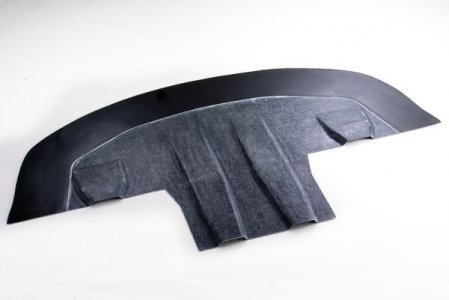So for my situation the opinions in this thread are very useful - I'm now of the opinion the DF-R is worth a try. But in the end proper engineering tests / measurements of the thermal efficiency of the ducted vs guided solution is the only real confirmation.
To amplify: consider radiator efficiency if the enclosed duct was only (say) a 2 inch tube? Clearly this would be restrictive. So their is an optimum design, which i expect is a ducted solution, and I would really like it to be the DF-R design, but it could still turn out (after measurement) to be the guided solution - IMHO :smile:
Yeah, I hear ya buddy. I did a project for my Thermodynamics and Heat Transfer Professor my senior year of my BSME degree, it was on air stream flow control and thermal efficiency of a bench top HVAC experimental device. I had to re-calibrate all the installed data acquisition sensors, then verify all the heat transfer coefficients for the evaporator. Flow regime, from low fan setting variably to highest fan setting.
This was all in an enclosed duct with velocity sensors sampling 1/3 dia away from evaporator with enclosed fan without flow straighteners. It was a fixed length duct with mist injection, heater, fan and evaporator; the whole design was compromised to fit within a set footprint and go from laminar Re values to fully turbulent values. How do you know when you have maxed out your radiators rate of thermal transfer? (This calc involved a compressible working liquid, R-134, that changed phases and included mixed phase mass flow through the evaporator if you threw to much airflow at the evaporator, headache? Yes, until a buddy posed the possibility. Verified based on mass flow, delta P and T from data set; uses an extra calc all by itself.) Had to calculate that based on a round tube and fin evaporator with silver soldering. Ever sit around and count fins and wonder if you need more?
The velocity profile across the diameter of the round duct were less than uniform and not parallel to the long axis of the duct. How do you average that flow mess out to calculate mass flow with only a single sensor at that length on the duct? Budget constraints force funny engineering solutions. This is the same thing, duct, fan, heat exchanger, entrance, exit. The only difference was I didn't have to worry about area change along the length of the duct. Never the less, area change effects local velocity which changes local pressure. It's all in the transitions here, specifically the exit and entrance.
A little off topic, but I think you will find this funny too. Went to a speed shop to drop off a friends car, saw a tech cutting some mesh screen out of an elbow transition on a middle sized inter-cooler entrance. The inlet side; the transition was at a 20+ degree transition angle. This is horrible and guarantees stalled areas and doubles the pressure resistance of the transition. Worse it kills even flow through the heat transfer area. I tried to explain to the guy he was making a horrible mistake, no go! The mesh did add a small local pressure rise, but maintained attached flow through the transition; this is what made the small inter-cooler work. It diffused the flow evenly and promoted even flow through all the tubes.
Later I heard they ordered a 2x larger inter-cooler, because the first one was just too small and wasn't working. They needed a bigger one for their build, same manufacturer. Guess what they did when they went to install it, cut the mesh screen out. Sigh!
Again not the techie type but I can follow layman's logic :wink:
When considering a radiator duct design, let's not forget if the mating is done to the OEM radiator and fan shroud or to aftermarket ones.
To clarify, the OEM fan shroud does NOT cover the entire radiator, it has gaps of about 2-3" (IF i RECALL) at both ends. Hence the DF-R duct will leave air flowing through the ends bouncing inside under the hood looking for an escape. Surely this will cause some inefficiency aero or otherwise.
The Type-R radiator duct is a good/reasonable option for those running an OEM fan/shroud or similar ones such as stand alone fan.
The DaliRacing duct is more efficient in both OEM and aftermarket setups - like the dual Spal fan with shroud I posted - because it captures more of the air flowing through the radiator (with or without a shroud). Per my shade tree mechanic R&D, the Type-R duct's edge is set inside the top radiator hose; whereas the DaliRacing goes behind it. With the dual fan I have, the Type-R would not be efficient nor as effective. On the other hand, Dali's duct can be further improved by making the fit with the hood duct more of a tighter seal - hence the experimentation of adding some further height to it - such as a garage door dust seal :tongue:
I am still looking for an option of making a duct that combines the Dali features with a more tight seal using the hood duct as well. Will be happy to accept your preorder dollars :biggrin:
Don't let air bleed around the entrance prior to the radiator, transition shape matters. Depending on depth of shroud, past the radiator, and the angle of wall transition, will hugely determine if you stall areas of flow through your radiator. The more stalled or obstructed the radiator the less effective your results. The fans don't have to be mounted right on top of the radiator to work well, most are to minimize depth because of working space. Doesn't mean it is the best design. Mass flow and area are the only concern, you design to the median working air velocity at the radiator face based on the radiators thermal design. (Flow the air past the whole radiator face at the speed which maximizes it's heat transfer. The median H20 flow rate comes into play to determine this and having glycol changes the calculation from pure water.)
Mass flow, channel shape, area change, entrance and exit transition all affect the pressure profile to the exit. Adding less restrictions is obvious, but dealing with size limitations just makes it more fun.












